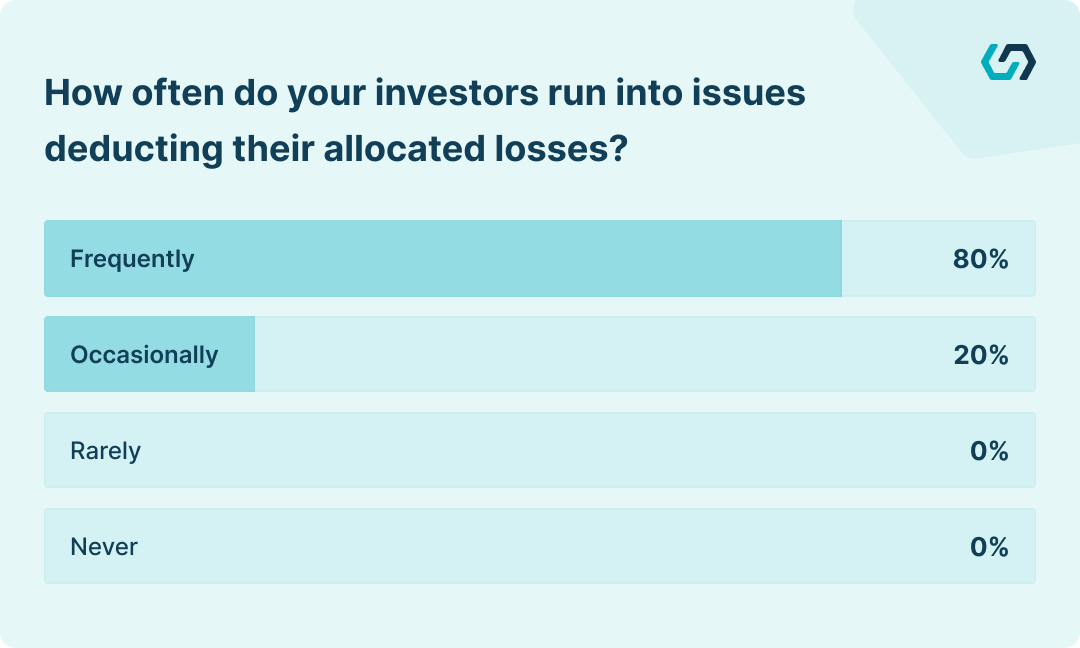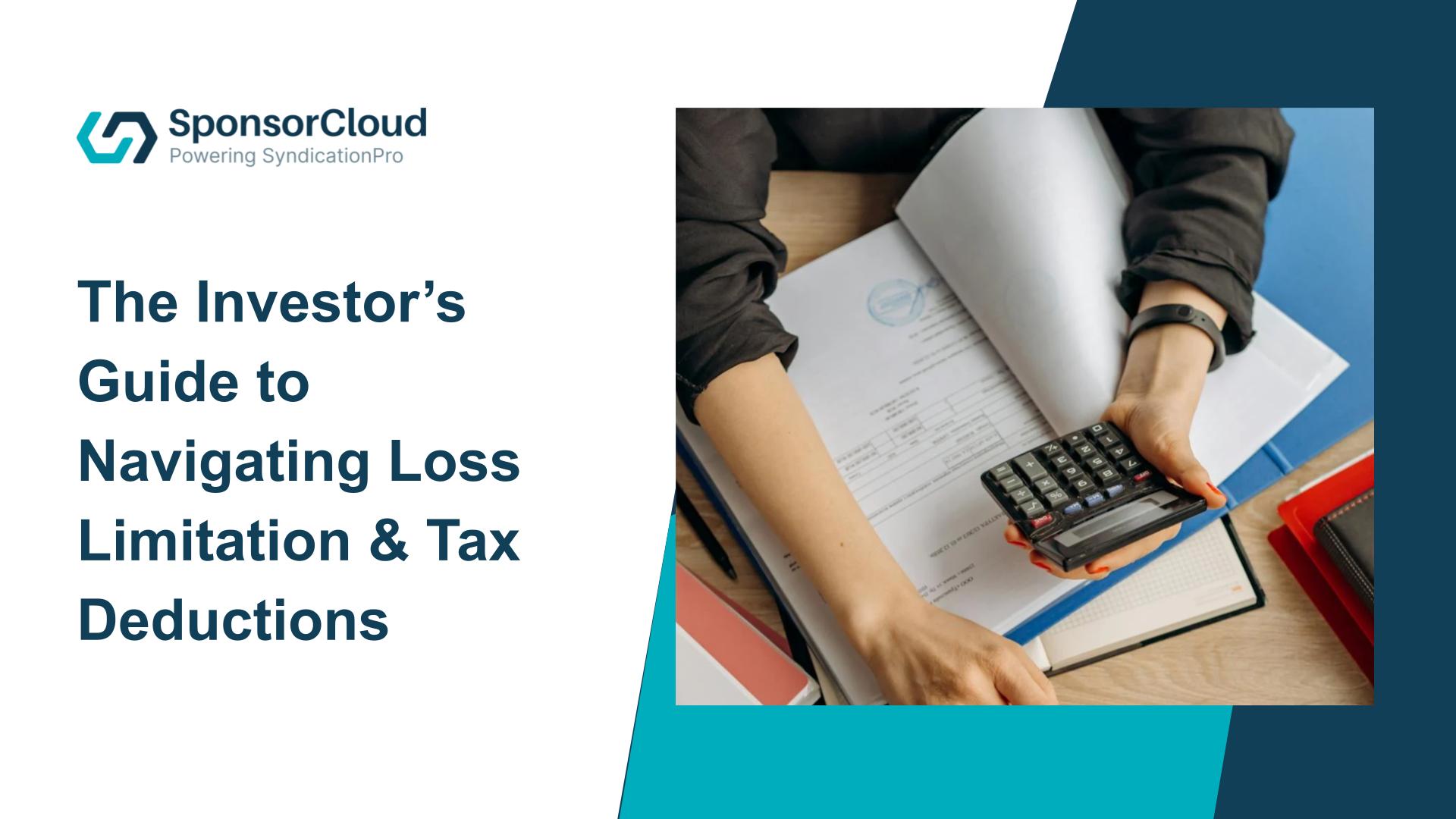

Table Of Contents
Many real estate investors expect rental losses to lower their taxable income, only to find that IRS rules prevent them from deducting those losses. This can often lead to unexpected tax liabilities and frustrated investors who assumed they could offset their income.
As someone who has worked closely with fund managers and deal sponsors, I've seen how loss limitations impact investor tax planning. That's why I hosted a webinar on Maximizing Investor Loss Allocations, covering why losses get suspended and how investors can structure their investments to avoid these tax restrictions.
If you missed the session, this article breaks down the biggest obstacles to loss deductibility, a real-world case study, and the strategies investors can use to protect their tax benefits.
Understanding Loss Limitations: The Three Major Hurdles
Our webinar poll confirmed what many of you already know: 80% of fund managers report their investors frequently struggle with deducting losses, while the remaining 20% encounter these issues occasionally. Not a single respondent indicated this was rare or never an issue.

This creates a significant opportunity for fund managers who understand how to structure investments for optimal tax outcomes. Let's examine the three primary obstacles to loss deductibility:
1. Basis Limitations
Tax deductions for an investor are limited by their "outside basis" in the investment, which includes both the cash contributed and their share of partnership debt. If an investor does not have sufficient basis, any excess losses are suspended and carried forward to future years.
For example, an investor with an $800K basis (consisting of $500K in cash contributions and a $300K debt allocation) can deduct up to $800K in losses.
2. At-Risk Rules
Deductible losses are limited to the investor's "at-risk" amount, which includes money personally invested and recourse debt—loans for which the investor is personally liable. For limited partners, nonrecourse debt generally does not count toward the at-risk amount, making it a key distinction in loss deductions.
While mortgage debt is considered "qualified nonrecourse financing," it may still not increase a limited partner's at-risk amount, potentially limiting their ability to deduct losses.
3. Passive Activity Loss (PAL) Rules
Most rental investments are considered passive activities, meaning losses from these investments can only be used to offset income from other passive sources. Without meeting specific qualifications, passive losses cannot be used to offset wages, business income, or capital gains.
From a tax planning perspective, the IRS refers to passive income sources as "PIGs" (Passive Income Generators), which can absorb "PALs" (Passive Activity Losses), helping investors manage their tax liabilities strategically.
Case Study: The Deductibility Gap
To understand these concepts, let's examine a real-world scenario that demonstrates how these limitations work in practice.
Roger Altman's Investment in Sierra Nevada, LLC
Roger, a limited partner, invested $500K for a 10% interest in Sierra Nevada, LLC. In Year 1, he was allocated $600K in rental losses. He has a nonrecourse debt allocation of $300K and passive income of $50K from other sources.
Here's what happened to Roger's deductions:
- At-Risk Limitation: With $500K at risk (his cash investment only), $100K of losses were suspended.
- Basis Limitation: His basis was $800K ($500K cash + $300K debt allocation), so this wasn't a limiting factor.
- Passive Loss Limitation: Of his remaining $500K in losses, only $50K could offset his passive income, leaving $450K suspended.
So, out of Roger's $600K in allocated losses, only $50K was immediately deductible. The remaining $550K ($100K at-risk suspension + $450K passive loss suspension) was carried forward to future years.
What Roger Could Have Done Differently
With proper planning, Roger could have:
- Increased his at-risk amount by personally guaranteeing some partnership debt.
- Qualified for Real Estate Professional status to avoid passive loss limitations.
- Used a grouping election to combine multiple rental activities.
Strategic Solutions to Maximize Loss Deductibility
Our polls revealed how fund managers assist investors in navigating these tax rules. While 43% provide general guidance, 29% take it further by collaborating with CPAs to structure allocations effectively. Another 14% focus on investor education, and the remaining 14% acknowledge the need for improvement in this area.

These results highlight a clear opportunity—strategic planning is essential to ensure investors maximize their loss deductions and avoid unnecessary suspensions. The following solutions outline practical ways to achieve this.
Solution 1: Qualifying for Special Status
Active Participation Exception
Investors who own at least 10% of a rental property and participate in management decisions may qualify for the active participation exception. This allows them to deduct up to $25k in rental losses annually.
However, this benefit phases out for investors with an adjusted gross income (AGI) exceeding $100k. Additionally, married couples filing separately who live together are not eligible for this exemption.
Real Estate Professional (REP) Status
Often considered the "Holy Grail" of loss deductibility, REP status removes AGI limitations and phase-outs, offering significant tax advantages. To qualify, an investor must spend at least 750 hours annually on real estate activities and devote more than 50% of their total working hours to real estate.
A key family planning opportunity exists—only one spouse needs to meet the criteria for the status to apply on a joint return. Maintaining REP status requires detailed, contemporaneous records of hours worked to substantiate claims in case of an IRS audit.
Material Participation: Critical for REP Status
Material participation is distinct from active participation, despite the similar terminology. The IRS uses a seven-part test to determine whether an investor meets the material participation standard.
An investor can qualify by meeting any one of these criteria, including working at least 500 hours in the activity or working more than 100 hours while contributing more time than any other individual involved. Other technical criteria may also apply, depending on the specific circumstances.
Solution 2: Strategic Operating Agreement Provisions
Fund managers and sponsors can strategically structure loss allocations through well-crafted Operating Agreements to maximize tax benefits for investors. By directing more losses to those who can fully deduct them, they help reduce suspended losses and improve overall tax efficiency.
For example, if one investor qualifies for Real Estate Professional (REP) status while others do not, the agreement can allocate a greater share of losses to that investor, ensuring those deductions are immediately usable rather than suspended.
Solution 3: Advanced Tax Planning Strategies
Grouping Election (§469(c)(7)(A))
Investors can utilize a grouping election to combine multiple rental properties into a single activity for tax purposes. This strategy helps satisfy material participation tests by consolidating time spent across different properties.
However, this election is mostly irrevocable and applies to all grouped properties, requiring careful consideration before implementation. To take advantage of this strategy, investors must make a special disclosure on their tax returns.
Short-Term Rentals (STRs)
Short-term rentals, such as Airbnb properties or RV parks, offer an alternative way to bypass passive loss restrictions. If the average guest stay is under seven days, the rental activity may qualify as non-passive, allowing investors to deduct losses against non-passive income.
Additionally, material participation requirements for STRs are generally less stringent than those for Real Estate Professional (REP) status. Investors can strengthen their case by providing qualifying services, such as guest concierge services, on-demand cleaning, and managed check-ins.
Carryforward Cures
For investors with previously suspended losses, several strategies can help "cure" the suspension and unlock deductions.
At-Risk Carryforward Solutions
To increase the amount at risk and free up suspended losses, investors can:
- Contribute additional capital as a partnership/LLC contribution.
- Contribute property of equal value to increase the at-risk amount.
- Secure recourse debt by personally guaranteeing a portion of the partnership’s obligations.
- Wait for a year when allocated profits are sufficient to absorb the suspended loss.
Basis Carryforward Solutions
If the limitation is due to insufficient basis, investors can:
- Make additional capital contributions to increase their overall basis.
- Contribute property of similar value to raise the basis amount.
- Secure a larger share of partnership debt, either by assuming recourse debt or increasing personal liability.
- Encourage the partnership to take out nonrecourse debt, ensuring each partner’s allocation is enough to support loss deductions.
- Wait for a profitable year when the investor’s income allocation allows for full loss utilization.
Passive Activity Loss (PAL) Carryforward Solutions
Because passive losses can only be deducted against passive income, investors need to either generate more passive income or exit the investment.
Generate More Passive Income (PIGs)
- Invest in cash-flowing rental properties or low-risk mature businesses structured for passive income.
- Hold intellectual property that generates passive royalties.
- Personally own rental real estate (outside of partnerships).
- Note: Interest and dividends from brokerage accounts do not count as passive income.
Sell the Investment to Unlock PALs
- Personally held assets: Selling the investment releases PALs in the year of the sale.
- Partnership interests: Selling the interest allows suspended losses to be deducted immediately.
Pro Tips
- Avoid 1031 exchanges if the goal is to free up suspended PALs—these defer gains but also delay PAL utilization.
- Grouping elections under §469(c)(7)(A) can change how PALs are treated, potentially removing their suspension altogether.
- Selling at a loss removes the suspension immediately while selling at a gain keeps PALs suspended until passive income offsets them.
By proactively managing at-risk amounts, basis, and passive income strategies, investors can ensure that valuable deductions aren’t trapped indefinitely.
Taking Action: Implementing Tax-Efficient Structures
According to our webinar poll, the biggest challenges in educating investors about loss allocations stem from common misconceptions and complexities. Nearly half (43%) of fund managers reported that investors tend to focus solely on distributions while overlooking tax strategy.
Additionally, 29% cited confusion around passive versus active loss rules, while another 29% struggled to explain loss utilization without crossing into tax advice.

These insights highlight the need for clearer communication and structured guidance to help investors make informed tax decisions.
Many investors miss tax-saving opportunities simply because they don't prioritize tax planning. Fund managers who proactively structure loss allocations provide investors with practical ways to utilize real estate tax benefits.
To bridge this gap and help your investors maximize their tax benefits:
- Review existing Operating Agreements for tax allocation provisions
- Educate investors about documentation requirements for REP status
- Consider investor tax profiles when structuring new offerings
- Consult with tax professionals during the formation stage, not just at tax time
Partner with SponsorCloud for Tax-Optimized Investment Structures
SponsorCloud has served 1,000+ fund managers and deal sponsors, managing over $10B in investor capital and 300,000 investor profiles. Our Professional Services team offers strategic, proactive tax compliance solutions tailored specifically for real estate investors.

To learn how we can help you implement these strategies and create tax-efficient investment structures for your investors, book a call with us today.
This article is based on our recent webinar "Maximizing Investor Loss Allocations" presented by Harisimran Khalsa, CPA, President of Professional Services at SponsorCloud.

.png)

%201%20(1).svg)

